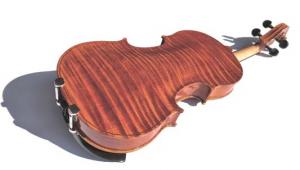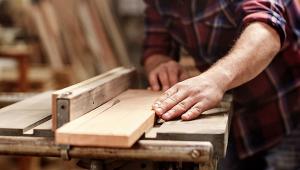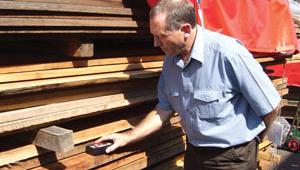How does wood work?
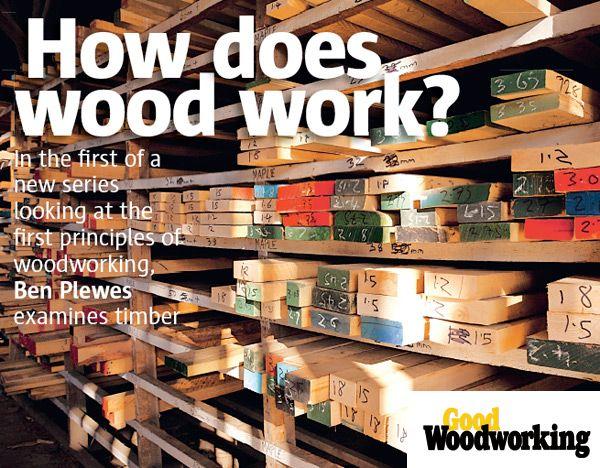
Words & pictures by Ben Plewes
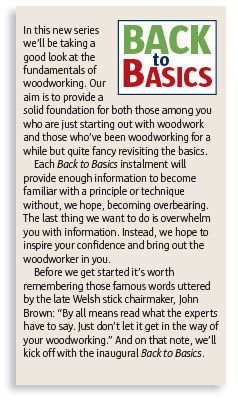
In this first instalment we're going to start at the beginning with a subject that is, surprisingly, often overlooked - the material we work with. At its most basic level the materials we use most of the time fall
into two categories. The first is naturally occurring timber which is divided into two further subcategories - hardwoods and softwoods. The second category is made up of man-made boards which fall into three subcategories - plywoods, particle boards and fibre boards.
The reason we're starting Basics with a discussion of these two very different material categories is because they require different methods of construction, an understanding of which is essential if we're to get the best out of our woodwork.
Hardwood or softwood?
Here's an easy to remember rule of thumb thats accurate for the majority of cases.
Hardwoods tend to be deciduous meaning they lose their leaves in winter. While most hardwoods are indeed hard, some are soft. Balsawood is the softest commercially available hardwood and is softer than most softwoods!
Softwoods are usually coniferous and tend to keep their leaves all year round. While most softwoods are - you guessed it - soft, some are hard. A good example is larch.
Before reaching the workshop
Regardless of whether the wood you use comes from a mainstream DIY store or a specialist timber supplier, it all goes through a similar process before it's usable in any kind of domestic project, the likes of which tend to adorn the pages of Good Woodworking.
After a tree is felled it has to be converted into planks ready for drying.
This conversion used to be achieved with a pit saw; two sawyers, one above the log, the other below in a pit, would alternate pulling a two-man saw. The sawyer above would guide the saw along the log while the man below would provide the muscle in often cramped and difficult conditions.
Pit sawing is still used in some countries where labour is cheap and power scarce. However, most log conversion is, thankfully, now mechanised. Large circular saws or, more commonly, vertical bandmills are used to convert logs into planks.
Once planked, the next stage is to season the timber. Seasoning refers to the process of reducing the moisture content within timber in a controlled manner. This is achieved in one of two ways, or often a combination of the two. The first method is kiln drying where sawn timber is stacked in a heat and moisture controlled sealed space with a continuous air flow to bring the moisture content down over a period of weeks. This expensive process has to be carefully controlled because if the timber is dried too quickly it can lead to a breakdown of the woods internal structure which, in turn, leads to all sorts of problems later on.
Other problems can occur too, such as case hardening where the outside of timber dries at a much quicker rate than the inside. This becomes evident as the drier outside layer shrinks and splits as it no longer fits around the wetter, larger core. Due to the expensive nature of kiln drying, getting the correct balance between speed and ample drying time is crucial if the wood is to be of sufficient quality and competitively priced.
The second method is air drying which takes much, much longer than kiln drying. We're talking years instead of weeks here. The rule of thumb requires a hardwood plank be air dried for one year for every inch of thickness plus an additional year. Air dried timber often spends a short period of time in a kiln at the end of the drying process to bring the moisture content down to a usable level.
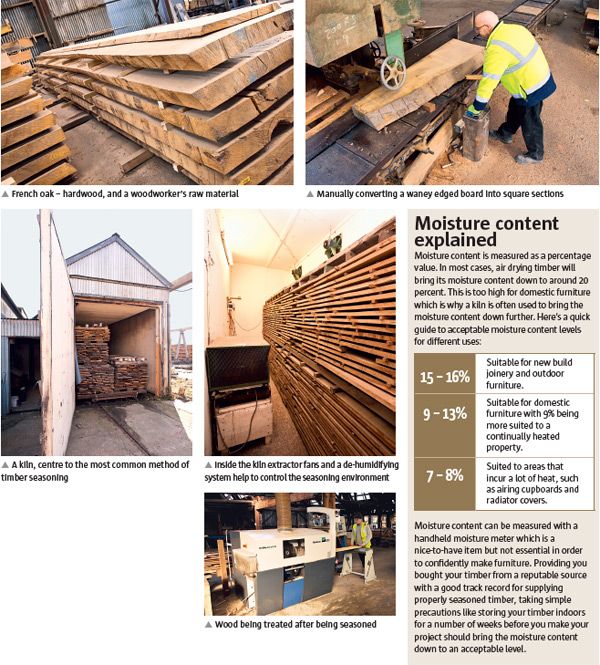
Why is moisture content important?
There is a general misconception that once wood has been seasoned you don't need to worry about its moisture content anymore. If only life were that straightforward! Wood continues to expand and contract after the initial drying process is complete. In fact wood, even with a synthetic finish applied, will continually adapt to the ambient moisture level that surrounds it. It's a slow process so you're not going to see your wood move the minute you open a window but it will move over a period of weeks to match the average conditions around it.
Its for this reason that the construction methods we opt to use must take into account this continual movement and allow the timber to adapt without stressing our joints. If we dont take this approach we end up with splits, cracks, warps, gaps and all manner of undesirable things.
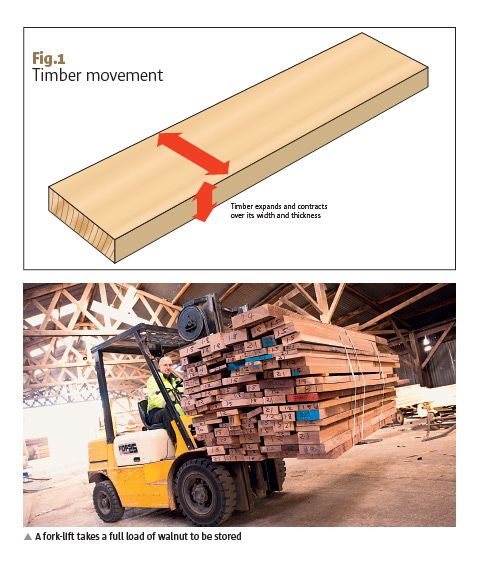
How does wood move?
Wood expands and contracts most noticeably across its grain i.e. at right angles to the grain direction. It expands and contracts both in width and thickness, but not significantly in length, as it adjusts to the fluctuating temperature and humidity levels that surround it. Other factors such as the timber species and the way it was cut during the initial conversion process also have a bearing on the amount of movement that will take place but these are concepts beyond the scope of this article.
The important fact to remember at this stage is that the timber movement is most noticeable across the width of a board and its because of this predictability of movement that we use the construction methods we do when building furniture.
Controlling movement
Once you've acquired your seasoned timber the best thing to do is bring it indoors for approximately six weeks prior to using it. Ideally it should be stored in the same room as it will eventually live as a piece of finished furniture but this is, more often than not, too impractical. As a compromise it's a good idea to find an area of your house that approximates the same conditions as the room where the finished piece will live and store the timber there for a time.
After a period of several weeks the moisture content of your timber should have adjusted to a level that you can safely use but it's still vital that before you make anything you design its construction around the way that timber moves, because, as weve already discussed, it will move! Even if your finished piece lives in the same centrally heated room its entire life, the temperature and humidity levels will fluctuate between the seasons. If your piece becomes a family heirloom or you sell it then the chances of it ending up in unforeseen environments are high. Therefore, and I can't overstate this, it's crucial that you design your solid wood furniture with timber movement in mind.

Suitable construction methods
In the future, the Back to Basics series will be looking at various ways to design around timber movement. Such methods as the mortise and tenon, the dovetail joint, and frame and panel construction have all been developed to compensate for timber movement. We'll take a good look at all these and more in enough depth to give you confidence in choosing which is right for the job at hand.
Board materials
Working with board materials is generally much simpler than working with solid wood because man-made boards have been designed with dimensional stability in mind meaning any expansion and contraction is minimal.
Here's a summary of the three types of man-made boards you'll be most likely to use when woodworking:
Plywood is made from layers of solid wood glued together. Each layer has its grain direction at right angles to the one either above or below. Plywoods come in different thicknesses with varying numbers of layers. The higher the number of layers the higher the quality is likely to be. Therefore, a five ply (five alternating layers) will be superior to a three ply given the same overall thickness.
Laminboard, blockboard and battenboard all come under the general category of plywood because they all have at least three layers with alternating grain directions. Its worth mentioning here that these materials aren't, for better or worse, as common as they used to be because of the widespread adoption of MDF (Medium Density Fibreboard) throughout the furniture industry.
Particle boards are made up of wood chips bonded together with synthetic resin glues and formed into sheets. They are commonly referred to as chipboard and are relatively cheap when compared to plywoods and fibre boards. A common use for chipboard is in kitchen cabinet construction where MFC (Melamine Faced Chipboard) is used to create cabinet carcasses.
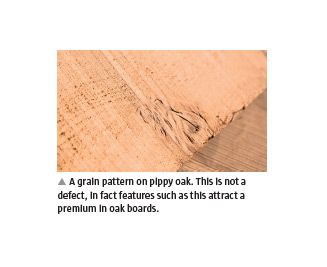
Fibre boards are by far the most common man-made boards available today. They are made by compressing wet wood fibres in a heated press to specific densities. MDF (Medium Density Fibreboard) is the most common type in use in the furniture industry and is available in water and fire resistant variants. Hardboard, commonly used for cheap drawer bottoms and cabinet backs is also classed as a fibreboard.
Many of the above types of man-made boards are available with different veneered faces for use in conjunction with solid wood. Various techniques can be employed to give the impression that a board material is solid wood in a finished piece of furniture. For example, solid wood edging can be applied around the perimeter of a veneered board to obscure its core construction. In lower quality furniture, board edges are often moulded with a router, exposing bear MDF, which is then stained to match the colour of the veneer used.
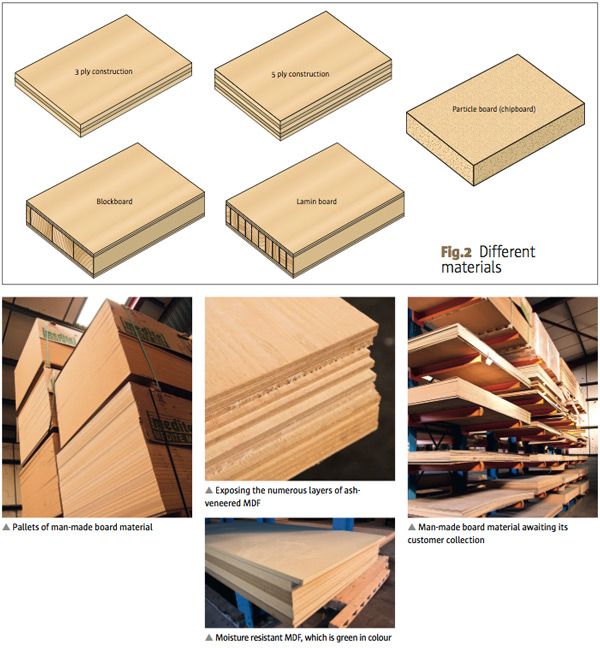
Man-made boards in use
Because of their structural stability, man-made boards can be used without fear of shrinkage and expansion, though care must still be taken not to expose these products to excessive moisture. Standard MDF for example, is useless for outdoor projects. Special moisture resistant grades must be used for bathroom projects while outdoor projects are best left to external grade plywoods.
Because of their general ease of use, skill levels required for working with board materials are lower than those required for solid wood. Boards can be cut and jointed easily with basic power tools, with little need for complex joints. We'll be looking at this in more depth in future issues.
And that wraps up this first instalment of Back to Basics. The subject of materials and their preparation prior to use is a big one - I hope Ive managed to get the basics across in this relatively short article. If you have any questions then please do get in touch and well do our best to answer them.
- Log in or register to post comments
